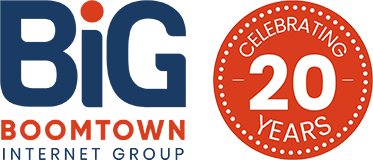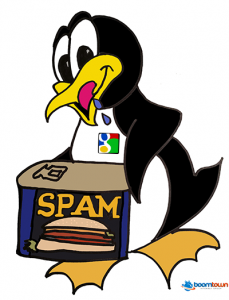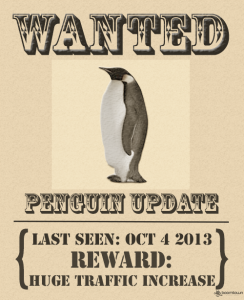We’ve Been Waiting Forever – But Do We Really Want a Penguin Update Right Before the Holiday Season?
Panda 4.1 rolled out on Friday and while we welcome another content refresh, we are really waiting for Penguin!
Hello Google. We’ve been very good….We’ve been following all the updates to your guidelines and trying hard not to create Spam since your very first Penguin update on April 24th, 2012. Every subsequent update has been a bit more restrictive about what is an allowable link, and we’ll admit that the last update on Oct 4th, 2013 (almost a year ago) really redefined our definition of a bought link or Spam link. But we are ready now. We’ve been carefully monitoring our client’s back link profiles, and adding disavow files as often as we can into Webmaster Tools. And we have some clients (mostly because they signed on with us AFTER they were penalized) who are impatiently awaiting the benefits they hope to receive from this diligence and “good internet behavior” because they have been penalized for almost a year now. It’s a long time to wait.
What’s funny is that we’ve noticed some sites get away with blatant violations to your Spam link policy and rise above our clients with these tactics. We’ve seen them purchase guest blog links from sites that are sort of related to theirs but these sites have content that looks like it was regurgitated by writers working through Fivr.com. No one is reading those blogs, and if they actually had analytics installed on them, you’d know that Google, but the blog owners are smart enough not to host them on the same IP address and not to use gmail or analytics anywhere near them. We’ve seen the same low quality directory links used to generate hundreds of poor links to competitor sites, and waited for these to penalize our competitors. We’ve seen doorway page directories generated from Wordpress pop up briefly when new product announcements are made – and these blogs pop right to the top of search rankings for a week or two – just long enough to garner a lion’s share of traffic during the product launches.
We’ve seen a load of “negative SEO” against our clients in more competitive spaces too. For instance we see doorway pages put up, entire sites copied on domains that are owned by anonymous Chinese or Russian individuals who paid the hosting bill in cash and can never be found. (Thank goodness you have us the ability to submit DCMA takedown requests!) We’ve seen Yelp, Citysearch and Yellowbook locations entered in our client’s names that point to strip malls in Texas and that cause inconsistent citations and harm our client’s local search positions. Black hat negative SEO tactics are so common that we now devote a day a week to researching the back link profile and scrutinizing the brand reputation of our larger more competitive clients. Frankly it’s exhausting. And it isn’t really marketing, either, which is what we get paid to do.
We are hoping you do a Penguin refresh soon. When our clients fall from position 1 to position 4 or 5 on Google it’s a much bigger deal than it was a few years ago. Why? Two reasons. Ad space is increasing, and your market share is increasing. Because you have as much as 85% or the market share on many of the search terms our client’s use, and while most of them have fairly large Adwords budgets, they still receive the majority of their traffic organically. So when you do the next Penguin refresh, what can we expect?
Are the engineers who are diligently reviewing all those disavow files going to produce better search results when they weed out the main offenders? Do the Google engineers trust the work of marketing teams who tried to disavow the types of links they thought were the most offensive? Did purchased link disavow tools recommend removing the worst Spam domains and links? I wonder.
Maybe the reason that you have not produced another Penguin update is that you really wanted to hammer home the punishment so that sites refrain from spam. I vote that a year is long enough, and that websites cannot diversify online traffic outside of Google Ads, Youtube, Maps, and search well enough to supplement their income.
I also think that a Spam link is very difficult to qualify. Google passes judgment on links that are “bought” or gotten via tactics that were specifically designed to increase search rankings. But why else would we seek out links in the first place? We never really bothered too much with them until they were a significant part of the Google algorithm. Then we used whatever tactics we could to get the most links, the best links, and a continuous stream of links to our client’s sites. Show me a link that was actually free. I’ve never ever seen one. Someone was paid to write the guest post or contact the reporter, or put the site into a coupon directory. Your value of a link is more a question of the intent with which the link was created, I guess. But whether or not the Penguin algorithm is fair or not is a moot point. The fact that you, Google, control the profitability of so many businesses and income of so many individuals with these algorithmic changes smacks of a monopoly on information dissemination!
So Google, when you refresh Penguin, is it going to help all those websites that have been following your rules, and waiting for the update? And are you planning on doing this refresh just in time for the holiday marketing season so that businesses absolutely have to turn to PPC for visibility? That might be a good tactic for you Google, and perhaps will improve Adwords profitability this year.
Oh, and I don’t know if I mentioned this or not, but thanks again for refreshing Panda too!



